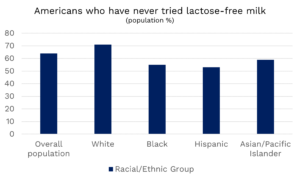Recent data is showing that even as snack food consumption stagnates, dairy-focused products such as Greek yogurt and cottage cheese are increasing sales volumes. NMPF Executive Vice President Alan Bjerga breaks down why in an interview with RFD-TV.
Recent data is showing that even as snack food consumption stagnates, dairy-focused products such as Greek yogurt and cottage cheese are increasing sales volumes. NMPF Executive Vice President Alan Bjerga breaks down why in an interview with RFD-TV.
NMPF’s executive vice president Paul Bleiberg tells the listeners of Dairy Radio Now about the passage this week by the House Education and Workforce Committee of new legislation that would increase the range of milk options available to school children. The Whole Milk for Healthy Kids Act would give schools the option of serving 2% and whole milk once again. The bill is now expected to move to the full House for further consideration.
Consumers are increasingly turning to whole milk, an important point to consider as Congress considers the Whole Milk for Healthy Kids Act, NMPF Executive Vice President Alan Bjerga says in an interview with Big Radio in Janesville, WI. Along with whole milk, consumers are also drinking more lactose-free varieties, an important part of the industry’s future.
NMPF’s executive vice president Paul Bleiberg discusses the current agenda for Congress as the leadership transitions in Washington from President Biden to President-elect Trump. Bleiberg also highlights that the USDA plans to soon open the 2025 sign-up for the Dairy Margin Coverage program, for those farmers not already enrolled in the federal safety net.
NMPF’s chief lobbyist Paul Bleiberg explains for listeners of Dairy Radio Now what Congress will focus on during the first few weeks of December in the congressional lame duck session that is following last month’s election. Members of the House and Senate will have to address government spending for 2025, but are not expected to pass a new farm bill in 2024, instead preferring to extend current policy and work on a new version next year.
https://www.rfdtv.com/keep-it-flowing-u-s-per-capita-dairy-consumption-returns-to-1950s-levels
NMPF Executive Vice President for Communications & Industry Relations Alan Bjerga discusses new USDA data showing that per-capita dairy consumption among Americans is back to 1950s levels, in an interview with RFD-TV. Robust holiday sales could push consumption to even higher levels. “We can do this, America,” Bjerga said.
NMPF’s chief lobbyist Paul Bleiberg assesses for listeners of Dairy Radio Now how the election of former president Donald Trump, along with a Senate majority led by the GOP, will impact dairy policy and agricultural issues in Washington and in farm country going forward.
It might sound crazy to think that a product that’s already in 94 percent of U.S. households has room to grow, but the numbers indicate it’s true. Here’s what we’re talking about:

This comes from a study done by the International Food Information Council, supported by NMPF and the International Dairy Foods Association, on consumption habits among diverse U.S. populations. What’s striking is that, even though self-reported lactose intolerance among non-White populations runs at roughly 30 percent (according to the same study), clear majorities among Black, Hispanic and Asian/Pacific Islander populations haven’t even tried milk that addresses that intolerance, forgoing an option that provides 13 essential nutrients. And presumably, some of those non-milk drinkers are in that 6 percent who don’t have it in their refrigerators.
(And conversely, some of that 94 percent must include lactose-intolerant consumers. Are they taking lactase pills to aid in digestion? Are other household members the milk drinkers? There’s still much to know.)
The point is this: At a time when the committee drafting recommendations for the next Dietary Guidelines for Americans is looking at nutrition science and contemplating recommendations that are appropriate to the lived experiences of a wide range of Americans, it’s important to meet people where they are. For the overwhelming majority of them, that means a place where they have milk in the fridge. Those who aren’t there are in a place where awareness of the numerous ways to benefit from dairy nutrition, regardless of lactose tolerance, isn’t what it needs to be.
That suggests a need to double down on offering dairy’s benefits in a way that’s tailored to the needs of individual communities. It means listening to communities that value dairy and wish it could be offered more readily, in more accessible forms. It means serving that 94 percent of households with milk — and using the tools available to raise that percentage. It emphatically does not mean de-emphasizing dairy as a critical nutritional option for all Americans — or even worse, suggesting it be replaced by sources that aren’t nutritionally equivalent.
NMPF has a call to action that dairy advocates can use to help get this message across. Public health, and the best public health guidance, is important to all Americans. And dairy is ready to provide high-quality nutrition that’s affordable and accessible to all.
 By Jaime Castaneda, Executive Vice President, National Milk Producers Federation
By Jaime Castaneda, Executive Vice President, National Milk Producers Federation
NMPF and the U.S. Dairy Export Council (USDEC) are working to preserve market access for American dairy exports to Colombia following the Colombian government’s abrupt July 5 decision to initiate a politically driven “subsidies and countervailing measures” investigation into milk powder imports form the United States.
The move has little to do with U.S. milk and everything to do with Colombia’s domestic politics. In an effort to reverse slipping popularity with voters, the Colombian government has decided to misuse trade tools usually reserved for private industry to counter legitimate damage from “dumped” product sold at below market rates. In contrast to this, Colombia’s government has instead launched this case on its own, alleging that U.S. milk powder exports from 2020 to 2023 were unduly subsidized by U.S. government programs and damaged Colombian dairy producers. Unfortunately, due to the investigation’s political nature, the Colombian government could impose tariffs on imported U.S. milk powder products as early as September 16. That would be certain to stifle trade to the market.
NMPF and USDEC have been working with U.S. exporting cooperatives and companies, legal teams, and the U.S. government to submit a strong, data-driven defense proving that this investigation is without merit.
In their counterarguments, NMPF and USDEC note that the investigation is baseless for many reasons, including:
Because of the political nature of this investigation, a fair result is not guaranteed, which means that U.S. government intervention may be necessary. NMPF and USDEC are urging U.S. Trade Representative Katherine Tai and U.S. Department of Agriculture Secretary Tom Vilsack to use all available tools to respond forcefully should Colombia impose tariffs on U.S. milk powder imports despite the lack of evidence meriting such a result.
Congress is also paying attention. A letter sent by the bipartisan leads of the U.S. House of Representative’s Agricultural Trade Caucus to the Colombian Ambassador to the United States highlights the U.S. dairy industry’s long-standing commitment to work with its Colombian counterparts and encouraged the two industries to work together to strengthen the dairy sectors in both countries instead of pursuing meritless investigations.
Colombia’s investigation will play out over months, starting with preliminary results and potential provisional measures as early as September 16, followed by a public hearing and additional comment periods.
At stake is $70 million in annual U.S. milk powder exports to Colombia.
While not a trivial amount by any means, this investigation could also set a dangerous precedent for like-minded governments to imitate. Over the past several years, protectionist sentiments have grown around the world, and Latin America is no exception. The region has become a battleground in the effort to preserve existing trade opportunities, flaring up from Peru and Ecuador to Brazil and Mexico.
While cooperating with the investigation, NMPF and USDEC continue to engage with policymakers and allied organizations to seek a positive conclusion. Regardless of which way this investigation turns out, it’s important for the United States to respond forcefully and let its trading partners know that such maneuvers will not be tolerated.
This column originally appeared in Hoard’s Dairyman Intel on Sept. 5, 2024.
What makes dairy so valued that milk alone is in 94 percent of U.S. refrigerators? Nutrition is one factor. So is affordability. But perhaps the greatest value is one that data supports: People trust it.
The dairy checkoff’s latest consumer perception tracker, conducted by Kantar Group, shows just how much confidence dairy has from consumers – and it’s a great contrast to the loud braying of the anti-dairy fringe, which takes up more brain space among the sane and grounded than should. Rated on a 1-7 scale of trust, with 1 being none and 7 being total, 58 percent of consumers rated dairy at 5 or above, according to the nationally representative sample of consumers aged 13-65.

That same survey, conducted last November and December, showed 35 percent either strongly or completely trusting dairy, shown by ratings of 6 and 7. That high trust level held across generations. Baby boomers led at 38 percent of strong or complete trust; Generation X, a cohort famed for trusting no one, was lowest at 33 percent. And the future looks stable and bright. About 34 percent of teenagers strongly or completely trusted dairy, with young adults at 35 percent and Millennials at 36. And again, these were the highest ratings of trust – including less-fervent support, clear majorities spanned generations.
Dairy also did well when compared with other foods and industries. Dairy’s 58 percent trust level compares well with beef (53), almonds (51), tech (53, sorry Zuckerberg and Musk) and finance (43 – with apologies to Wall Street).
To sum up: In an increasingly fractured climate plagued by misinformation, dairy continues to attract broad-based support across wide swathes of society. In a superpower nation where trust is declining, dairy has its own superpower – trust from consumers that remains strong.
Pretty heavy stuff, when you think about it. But dairy can carry the load, with unparalleled nutrition, uncommon consumer reach and high levels of consumer trust. It’s a refreshing situation, appropriate for refreshing products.